Welcome to the world’s only data-driven Marijuana Drug Test Passing Probability Calculator. Designed to predict the likelihood of passing a cannabis drug test, this calculator is built upon a foundation of comprehensive data and solid scientific understanding (Patent US 13/866,015).
Calculates Passing Probabilities For:
➤ Data Plots for Lab Tests
➤ Data Plots for Home Tests
➤ Untampered & Diluted Urine
➤ Blood Draw
Directions:
Completely fill in the following forms. When measuring the circumference of your waist, it is essential that you take the measurement at your belly button. The size of your pants is not a waist measurement and may skew the accuracy of your calculations.
This tool represents a powerful aid for those seeking to understand the complex interactions of THC, or Tetrahydrocannabinol, within the human body by leveraging over a decade’s worth of data gathered from thousands of real-world cannabis consumers who sent us their drug test results.
Be sure to use the Quick Navigation menu below. There you will find Body Type and Use Case Examples as well as more information about the forms and variables used for calculation. It will help you understand your graphed passing probability results and illustrate how much of a positive impact dilution and detox products can have on the outcome.
* If you’re searching for information about another topic in the realm of drug testing, be sure to use the navigation menu below:
Using the Marijuana Drug Test Passing Probability Calculator
To ensure the calculator delivers the most accurate results, users are encouraged to provide precise data on two key areas: Biometric Measurements and Cannabis Lifestyle Habits.
Note: Accurate data entry is critical for reliable results. Each piece of data plays a part in the comprehensive equation used to predict THC excretion times and drug test outcomes.
Once the necessary data is entered, the Marijuana Drug Test Calculator will crunch the numbers, culminating in a visual display of a user’s drug test passing probabilities plotted over time.
Step 1: Biometric Measurements
Accurate biometric measurements play a critical role in calculating the passing probability for a marijuana drug test.

Gender
Gender is an indispensable variable in our calculations. Men and women differ in body composition, especially regarding fat content. THC is lipophilic, meaning it has an affinity for fat cells. After absorption into the bloodstream, THC binds to fat cells. Over time, as THC levels in the blood diminish, the compound is released from these cells. Women generally have a higher percentage of body fat than men, which can result in THC being retained for longer periods. Consequently, females might take longer to pass a drug test.
It is noteworthy that it’s not the overall weight that is significant, but rather the weight of the body fat. It is the reservoir of these fats that harbors THC and its metabolites.
Insight: Gender-specific fat content plays a crucial role in THC retention and release. As women usually have a higher body fat percentage than men, they might experience extended periods of THC retention.
Height and Weight
We will now discuss how height and weight are employed to ascertain your Body Mass Index (BMI). BMI is a useful measure to estimate body fat percentage, which, as we’ve established, is vital in THC retention.
An individual’s BMI is an index that takes into account their height and weight to assess whether they have a healthy body weight. Higher BMI values usually correlate with higher body fat percentages, which may lead to longer THC retention times.
Waist
Another vital measurement is the waist circumference. This helps refine the estimation of body fat percentage. In conjunction with height and weight, waist measurement can be used to more accurately estimate the distribution and percentage of body fat. Central obesity or carrying excess weight around the waist can be an indicator of higher fat content, and thus longer THC retention times.
Your Age
Finally, we must touch upon the subtle but significant role that age plays in this calculation. As we age, our organs, including the liver and kidneys which are instrumental in excreting THC metabolites, begin to function more slowly.
Aging affects various physiological functions, such as kidney filtration rates, which in turn can affect how quickly THC metabolites are excreted from the body. This means that older individuals may retain THC for longer periods compared to younger individuals.
Key Takeaway: Age-related changes in organ function can impact the rate at which THC metabolites are excreted, with older age correlating with slower excretion rates.
Accurate biometric data is the foundation upon which the THC Drug Test Calculator operates. Gender, height, weight, waist measurements, and age all interplay to determine body fat content and metabolic rates, which are vital in calculating the probability of passing a marijuana drug test.
Step 2: Cannabis Lifestyle Habits
Your lifestyle habits related to cannabis use can significantly affect your drug test passing probability. We will discuss the role of smoking frequency, the amount of cannabis consumed, marijuana potency, metabolic speed, and cardio activity level.

Smoking Frequency
Smoking frequency is a crucial factor to consider in determining the drug test passing probability. As a rule, the more frequently you smoke cannabis containing THC, the longer it will persist in your system, extending the excretion time.
THC metabolites have a propensity to bind with the body’s fat molecules. Over time, with repeated smoking, these metabolites start to accumulate in the body. These stored metabolites are gradually broken down and released into the bloodstream, contributing to the THC level. Therefore, for a regular user, the THC metabolites built up over time take much longer to be completely eliminated.
Key Insight: The frequency of cannabis smoking is a significant factor affecting THC retention and excretion time. More frequent use leads to the accumulation of THC metabolites, extending their excretion period.
With the exception of single use consumers, how often a person uses cannabis and how much they consume each day accounts for the second largest factor we use in our calculations (Patent US 13/866,015) when determining a person’s drug test passing probability.
Amount Consumed
The amount of cannabis consumed also plays a considerable role in THC retention. In essence, the more cannabis you consume, the more THC is introduced into your system. This increased THC load takes longer to be metabolized and excreted from your body.
Marijuana Potency
The potency of cannabis used is often subjective, but it makes a marked difference in detection times. Users who consume low potency cannabis generally exhibit shorter detection times compared to those who use more concentrated forms, like dabs. This variable becomes more significant for infrequent users and those who use cannabis once or twice.
Metabolic Speed
Metabolic speed is another major factor in our calculations. There is a noteworthy correlation between the perceived metabolism rate of an individual and the actual results of their drug test. Metabolism essentially dictates how quickly your body can process and eliminate THC metabolites.
Cardio Activity Level
Finally, cardio activity level significantly influences THC excretion rates. Regular exercise, particularly cardiovascular activities, can increase the rate of THC metabolite excretion. When you exercise more, THC stored in fat cells is released into the bloodstream more quickly, subsequently being excreted faster. Moreover, regular exercise helps reduce the amount of THC stored in fat cells.
Takeaway: Regular physical activity can help expedite the process of THC excretion from the body.
Cannabis lifestyle habits have a profound impact on the probability of passing a marijuana drug test. Smoking frequency, the amount consumed, marijuana potency, metabolic speed, and cardio activity level all interplay in determining the build-up and excretion rates of THC metabolites. Understanding these factors can help you use the THC Drug Test Passing Probability Calculator more effectively.
Graphing Your Passing Probability Results
After using the Marijuana Drug Test Calculator, you’ll see a line chart representing several (4 plots) unique drug test passing probabilities — both laboratory and home tests and their respective diluted/detoxed and untampered counterpart predictions. This is an integral part of our tool and understanding it will provide you with a more comprehensive overview of your results. We’ll guide you on how to read the graphed results and discuss the passing probabilities of various drug test types.

Interpreting the Graphed Results
The line chart generated by our calculator represents your passing probabilities across time. On the left side, the Y-Axis signifies the passing percentile, indicating your chances of passing a drug test. The X-Axis, located at the bottom, represents the number of days it could take to pass. Each plot line is color-coded by Test Type, facilitating easy differentiation and comprehension.
Consider the example in the image provided. This user would have a 60% chance of passing a home drug test kit around the 31st day without diluting their urine. This point is denoted by the Blue Star on the chart. Now, if this individual prepared and correctly diluted their urine before the test, their odds of passing would increase significantly.
Key Insight: Increase water intake to dilute THC metabolites in your urine and significantly enhance the chances of passing a drug test.
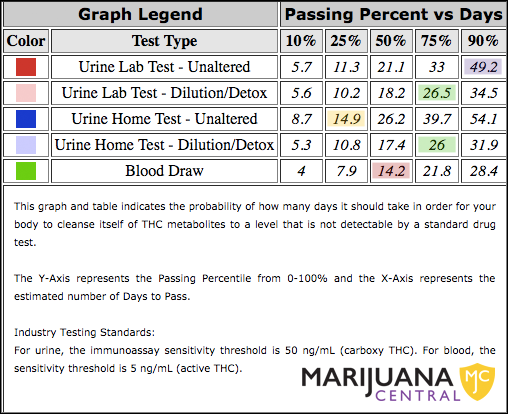
Impacting the Probabilities: Dilution and Detox
The concept of dilution can be applied across different types of tests, including lab urinalysis. For instance, as per the line chart example and indicated by the Graph Legend, there’s a 75% chance of passing a lab test on the 33rd day without dilution. However, this can change to a 75% chance of passing on the 26.5th day with proper dilution techniques.
Detox products can play an integral role in accelerating the body’s natural detoxification process, resulting in a quicker expulsion of THC and its metabolites. This accelerated detoxification can be translated into the drug test passing probability graph. Essentially, the proper use of detox products can shift the user’s passing probability lines on the graph towards a shorter timeframe. This implies that the user would reach a high passing probability at an earlier point in time as compared to without the use of detox products.
Detox Products: The use of proper detoxification products can help reduce the time needed to pass a drug test, increasing the passing probability.
In the context of blood draw tests, it’s important to note that failing a test several weeks after cessation is not uncommon. This has been reported by numerous cannabis consumers and is corroborated by our independent study. The prevalent belief that THC cannot be detected in blood after a few days is, in fact, false. Active and inactive THC metabolites in the blood can be detected up until a few days before they are no longer detected in urine.
Understanding how to read and interpret your graphed passing probability results can provide you with valuable insights into your own THC excretion process. It also highlights the significant impact of proper urine dilution and test type on your passing probability.
Detection Times for Different Cannabis Use Scenarios
A variety of factors can affect the duration that THC remains detectable in your system, including the frequency of use and the individual’s unique physiology. Here, we’ll delve into the specifics of various scenarios, from one-time use to the effects of body composition and athletic activity on THC retention.
Keep in Mind: The calculations provided are approximate averages. Individual results can vary significantly due to factors like metabolism, body fat content, and the potency of the cannabis consumed.
Single Use THC Detection Times
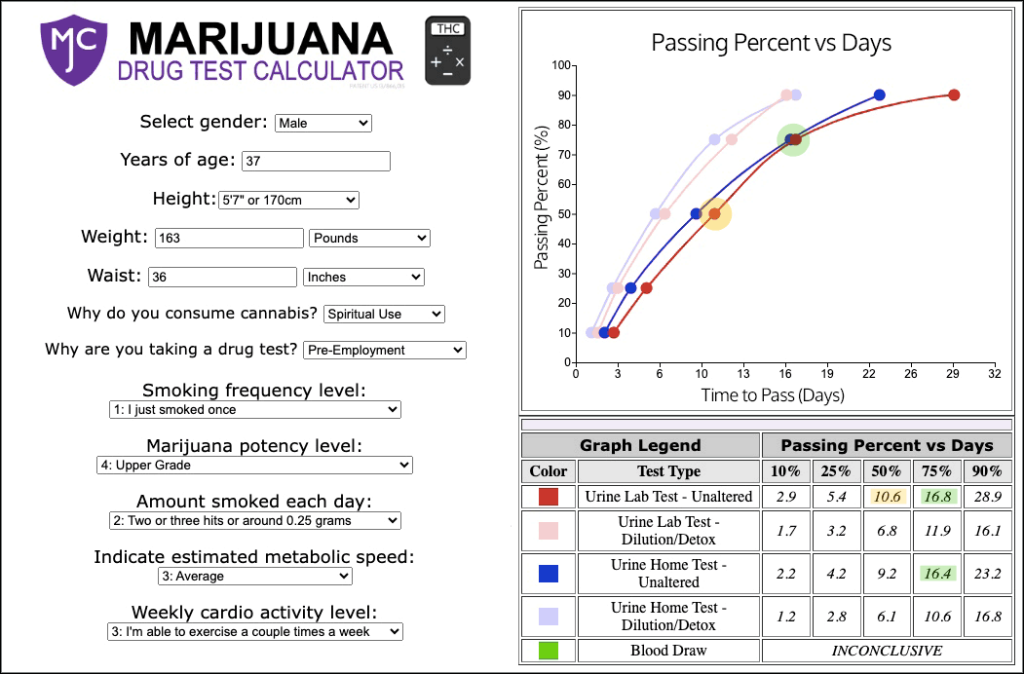
If you smoke cannabis only once, THC metabolites may be detectable in your urine for an average of 5-8 days. However, this range can vary from person to person based on individual metabolism, body weight, and overall health. Our THC calculator can offer a more precise estimation based on your unique parameters.
Effects of Regular Cannabis Use on THC Detection Times
If you’ve been smoking cannabis for several days in a row, THC can stay in your system for a more extended period. In this case, detection times can range from 10-30 days or even longer. The continuous use leads to accumulation of THC metabolites, extending the detection window.
Influences of Body Type on THC Retention
Body type plays a significant role in how long THC stays in your system due to its fat-soluble nature.
Skinny Individuals
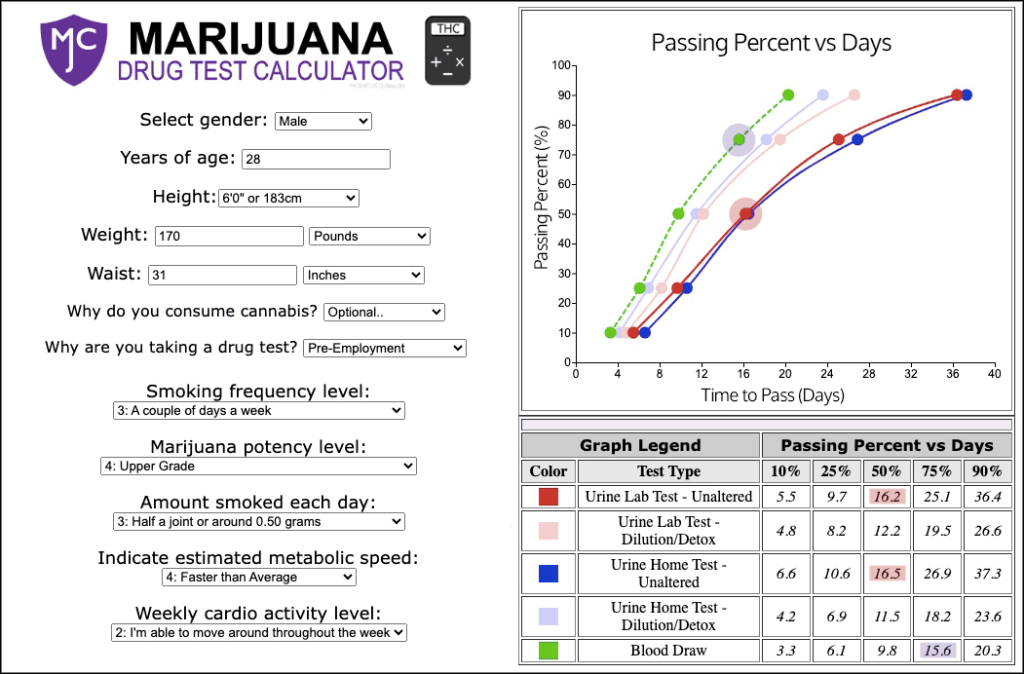
In a person with low body fat, THC metabolites may be detectable for a shorter period. This is due to the fewer fat cells available to store THC, leading to a quicker elimination process. However, it’s worth noting that everyone’s metabolism is unique, and so this duration can vary.
Obese Individuals
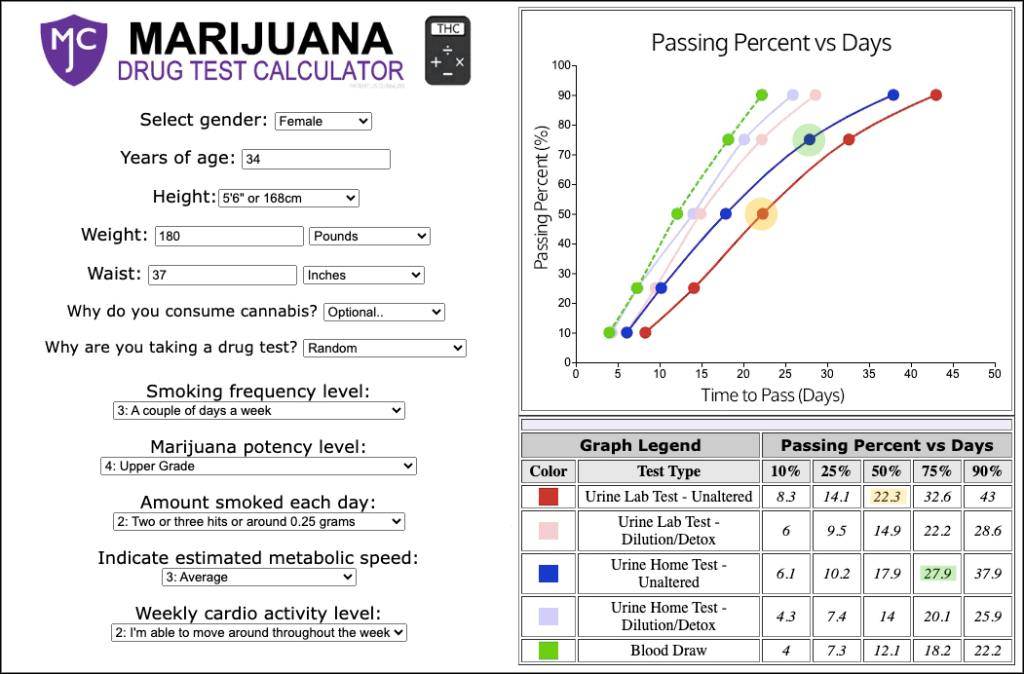
Conversely, THC can be detectable for a more extended period in an obese person, as more fat cells are available to store the THC metabolites. Therefore, using drug test products can significantly help obese individuals pass drug tests quicker by accelerating the detoxification process.
Role of Physical Activity: Athletes
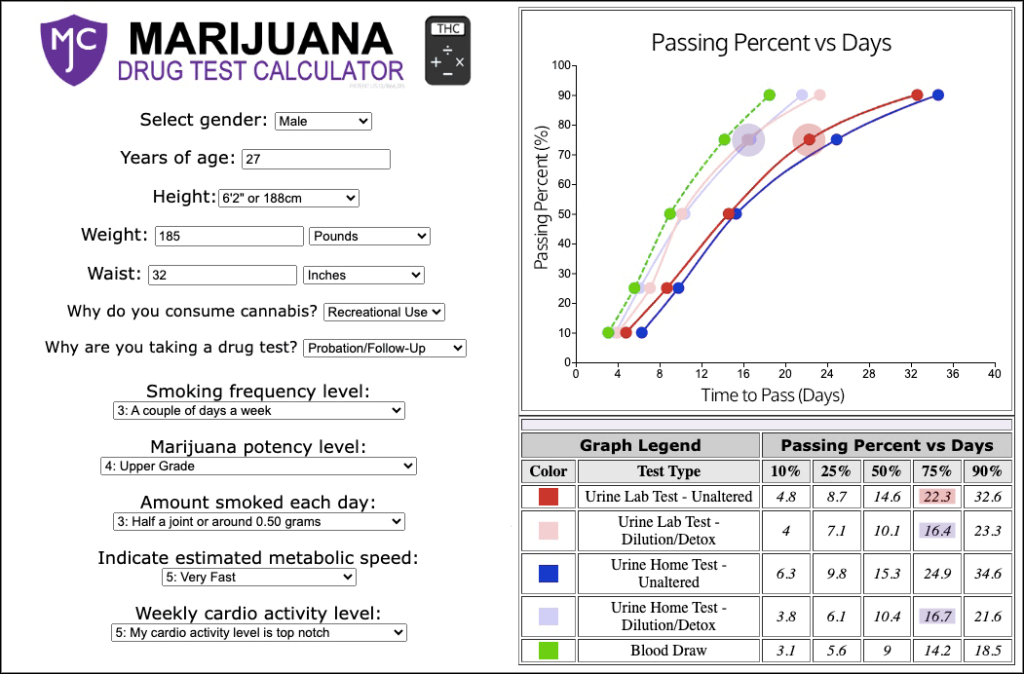
Physical activity and overall metabolic rate significantly impact the rate of THC excretion from your body. Athletes typically have lower body fat percentages and higher metabolic rates, factors that can contribute to a faster excretion of THC metabolites.
Please note: While physical activity can help in expediting the elimination of THC from the system, it’s crucial to remember that intense exercise close to the test date might lead to a temporary spike in THC metabolite levels in urine due to the release from fat cells.
Edibles and Their Impact on Detection Times
Consuming cannabis in edible form introduces THC to the body through a different metabolic pathway compared to smoking. As a result, the detection window for edibles may be slightly longer.
When you consume cannabis in an edible form, it goes through the digestive system and is metabolized in the liver before entering the bloodstream. This process takes longer, and the resulting metabolites can remain in the body for an extended period, leading to potentially longer detection times.
Important: When using the calculator, we treat an average edible dose (15mg THC) the same as smoking a joint, as in about a gram of flower.
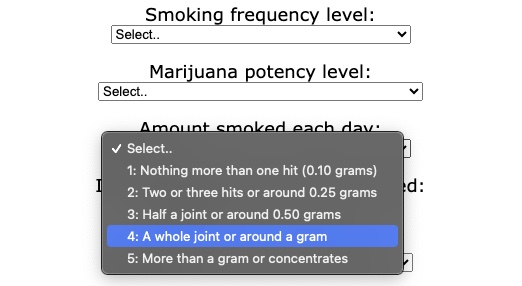
Understanding how various factors such as consumption habits, body type, physical activity, and the form of cannabis consumed impact THC detection times can significantly assist you in preparing for a drug test. Remember to utilize our Marijuana Drug Test Calculator for a better estimation of your drug test passing probabilities.
Detox Kits and Their Role
As you explore your drug test passing probabilities with our THC Calculator, it’s crucial to be aware of the broader picture. Detox Kits serve as valuable supplementary tools to the calculator’s predictions. These kits typically encompass a variety of products designed to expedite the body’s natural detoxification process, aiding in the more rapid expulsion of THC.
Detox kits, like any other tool, are more effective when used correctly and within the right context. They are designed to accelerate the expulsion of THC metabolites from your system, therefore helping cleanse your body in preparation for a drug test.
Important to Note: Detox kits aid in the detoxification process, but they are not a magic bullet. They should be used in conjunction with other strategies such as adequate hydration, diet adjustments, and exercise.

















